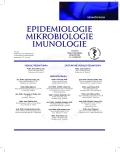-
Medical journals
- Career
Determination of antimicrobial activity of Achatina reticulata slime
Authors: D. Chmelař 1; R. Hinštová 2; J. Kuzma 1; M. Hájek 1
Authors‘ workplace: Katedra biomedicínských oborů, Pracoviště mikrobiologie a imunologie, Lékařská fakulta Ostravské univerzity 1; Katedra biologie a ekologie, Přírodovědecká fakulta Ostravské univerzity 2
Published in: Epidemiol. Mikrobiol. Imunol. 68, 2019, č. 2, s. 65-70
Category: Original Papers
Overview
Backgrounds: Snails (Gastropoda) have a mechanism for the production of a significant amount of slime and substances contained therein they use to protect themselves against bacterial or fungal pathogens. These active substances are involved in both humoral and cellular immune responses of the gastropods. The antibacterial or antifungal effect of the humoral immune component of slime lies in cytotoxic and haemagglutination activity against potential microbial pathogens. The activity of antibacterial agents present in Achatina reticulata slime against bacterial strains of Escherichia coli, Staphylococcus aureus, Klebsiella pneumoniae, and Pseudomonas aeruginosa was tested.
Material and Methods: A total of five samples of slime from laboratory reared Achatina reticulata were tested. To eliminate potential microbial contamination, slime samples were sterilized by UV radiation. To screen slime samples for antibacterial activity, the simple diffusion method on Mueller-Hinton agar was used. Samples diluted in guaiacol glycerol ether were used in the testing.
Results: The results show that the biologically active substances present in Achatina reticulata slime have an antimicrobial activity which is almost commensurate with that of the conventional antibiotics used to treat bacterial infections. The results of the determination of the antimicrobial effects of Achatina reticulata slime also highlighted viridation (partial hemolysis of erythrocytes after 24 hours of slime cultivation exposed to UV light for 60 minutes on Columbia blood agar.
Conclusions: The results of the antimicrobial activity testing of selected Achatina reticulata slime samples show that the gastropod slime contains biologically active substances with a relatively significant antimicrobial activity.
Keywords:
Achatina reticulata – antimicrobial activity of snail slime
Sources
1. Breakpoint tables for interpretation of MICs and zone diameters, Version 8.1 European Committee on Antimicrobial Susceptibility Testing, valid from 2018-05-15. Dostupné na www: http://www.eucast.org/fileadmin/src/media/PDFs/EUCAST_files/Breakpoint_tables/v_8.1_Breakpoint_Tables.pdf).
2. Ehara T, Kitajima S, Kanzawa N, Tamiya T, Tsuchiya T. Antimicrobial action of achacin is mediated by L-amino acid oxidase activity. FEBS Letters, 2002;531(3):509–512.
3. Jeong J, Toida T, Muneta Y, Kosiishi I, Imanari T, Linhardt RJ, Kim YS. Localization and characterization of acharan sulfate in the body of the giant African snail Achatina fulica. Comparative Biochemistry and Physiology - B Biochemistry and Molecular Biology, 2001;130(4):513–519.
4. Locker Eric S. Gastropod Immunobiology. Boston: Springer, 2010;17–43. DOI: 10.1007/978-1-4419-8059-5_2.
5. Pawar K, Dar M, Rajput B, Kulkarni G. Enrichment and Identification of Cellulolytic Bacteria from the Gastrointestinal Tract of Giant African Snail, Achatina fulica. Applied Biochemistry and Biotechnology, 2015;175(4):1971–1980.
6. Pitt SJ, Graham MA, Dedi CG, Taylor-Harris PM, Gunn A. Antimicrobial properties of mucus from the brown garden snail Helix aspersa. British Journal of Biomedical Science, 2015;2(4):174–181.
7. Santana WA, Melo CM, Cardoso JC, et al. Assessment of Antimicrobial Activity and Healing Potential of Mucous Secretion of Achatina fulica. J Morphol, 2012;30 : 365–373.
8. Shigeru I, Shimizu M, Nagatsuka M, Kitajima S, Honda M, Tsuchiya T, Kanzawa N. High Molecular Weight Lectin Isolated from the Mucus of the Giant African Snail Achatina fulica. Bioscience, Biotechnology, and Biochemistry, 2011;75(1):20–25.
9. Vieira TCRG, Costa-Filho A, Salgado NC, Allodi S, Valente A.-P, Nasciutti LE, Silva L.-CF. Acharan sulfate, the new glycosaminoglycan from Achatina fulica Bowdich 1822. Structural heterogeneity, metabolic labeling and localization in the body, mucus and the organic shell matrix. European Journal of Biochemistry, 2004;271(4):845–854.
10. Zhong J, Wang W, Yang X, Yan X, Liu R. A novel cysteine-rich antimicrobial peptide from the mucus of the snail of Achatina fulica. Peptides, 2013;39(1):1–5.
Labels
Hygiene and epidemiology Medical virology Clinical microbiology
Article was published inEpidemiology, Microbiology, Immunology

2019 Issue 2-
All articles in this issue
- Determination of antimicrobial activity of Achatina reticulata slime
- Surveillance of antibiotic resistance of Streptococcus pneumoniae in the Czech Republic, respiratory study results, 2010–2017
- Tularemia – zoonosis carrying a potential risk of bioterrorism
- Actinomycosis – an umbrella review and three case reports of severe pelvic actinomycosis treated conservatively
- In-vivo interspecies transmission of carbapenemase KPC in a long-term treated female patient
- Diagnosis and treatment of Bartonella endocarditis
- Clostridium difficile infection and colonisation in children under 3 years of age: prospective comparative study
- Reduction of Thymoglobuline from 7.5 mg/kg to 6 mg/kg in conditioning regimen extended time to the first cytomegalovirus detection after allogenic haematopoietic stem cell transplantation
- Epidemiology, Microbiology, Immunology
- Journal archive
- Current issue
- Online only
- About the journal
Most read in this issue- Actinomycosis – an umbrella review and three case reports of severe pelvic actinomycosis treated conservatively
- In-vivo interspecies transmission of carbapenemase KPC in a long-term treated female patient
- Tularemia – zoonosis carrying a potential risk of bioterrorism
- Clostridium difficile infection and colonisation in children under 3 years of age: prospective comparative study
Login#ADS_BOTTOM_SCRIPTS#Forgotten passwordEnter the email address that you registered with. We will send you instructions on how to set a new password.
- Career

